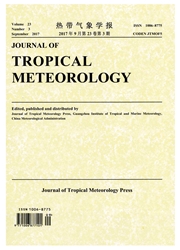

 中文摘要:
中文摘要:
用在 137 点的重复水道学的大小??
 英文摘要:
英文摘要:
Using repeated hydrographic measurements at 137°E, spatial-temporal variability of thermohaline intrusions in the northwestern tropical Pacific are investigated. Intrusions can be found in the main thermocline throughout the section, with their strength decreasing rapidly poleward. The strongest intrusions exist at the North Equatorial Countercurrent (NECC) where North/South Pacific thermocline water converges. These intrusions also exhibit temporal variations in strength which are closely associated with the meridional displacement of the NECC. Intrusion strength peaks in boreal winter when the NECC reaches its northernmost position of the year. At interannual time scale, intrusions tend to be weak (strong) during E1 Nifio (La Nifia) episodes. Variations in intrusion strength also lead to prominent fluctuation of lateral diffusivity KL and cross-front temperature flux Fo. Fo exhibits significant year-to-year changes which are well correlated with ENSO index, suggesting a possible role of intrusions in the low-latitude Pacific climate variability.
 同期刊论文项目
同期刊论文项目
 同项目期刊论文
同项目期刊论文
 Variations of SST and Thermocline Depth in the Tropical Indian Ocean During Indian Ocean Dipole Even
Variations of SST and Thermocline Depth in the Tropical Indian Ocean During Indian Ocean Dipole Even Low-frequency variability of the North Equatorial Current bifurcation in the past 40 years from SODA
Low-frequency variability of the North Equatorial Current bifurcation in the past 40 years from SODA Characteristics and salinity annual cycle of the subsurface water in the North Pacific tropical gyre
Characteristics and salinity annual cycle of the subsurface water in the North Pacific tropical gyre 期刊信息
期刊信息
